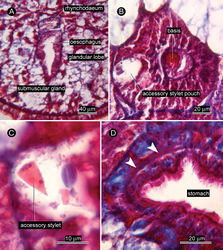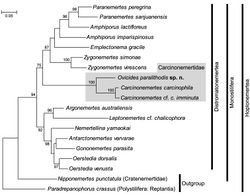Ovicides paralithodis
| Notice: | This page is derived from the original publication listed below, whose author(s) should always be credited. Further contributors may edit and improve the content of this page and, consequently, need to be credited as well (see page history). Any assessment of factual correctness requires a careful review of the original article as well as of subsequent contributions.
If you are uncertain whether your planned contribution is correct or not, we suggest that you use the associated discussion page instead of editing the page directly. This page should be cited as follows (rationale):
Citation formats to copy and paste
BibTeX: @article{Kajihara2013ZooKeys258, RIS/ Endnote: TY - JOUR Wikipedia/ Citizendium: <ref name="Kajihara2013ZooKeys258">{{Citation See also the citation download page at the journal. |
Ordo: Hoplonemertea
Familia: Carcinonemertidae
Genus: Ovicides
Name
Ovicides paralithodis Kajihara & Kuris, 2013 sp. n. – Wikispecies link – ZooBank link – Pensoft Profile
- Carcinonemertidae Form 4: Wickham and Kuris (1988)[1].
Material examined
Holotype: female, ZIHU 4271, serial transverse sections (8 µm thick) of anterior body fragment, stained with Mallory’s trichrome method, 5 slides. Allotype: male, ZIHU 4272, serial transverse sections (8 µm thick) of anterior body fragment, stained with Mallory’s trichrome method, 3 slides. The other specimen obtained (female) was destroyed and lost during preparation.
Diagnosis
An Ovicides without eyes; vacuolated, basophilic glandular lobes extending pre- and post-cerebrally; acidophilic submuscular glands scattered among basophilic lobes, not arranged in row; sexes separate; female and male about 1 cm and 5 mm in length, respectively.
Type host
Paralithodes camtschaticus (Tilesius, 1815) (Decapoda, Anomura).
Description
External features. In life, holotype (female) about 1 cm long, 0.9 mm wide; pale orange in colour (largely due to alimentary canal), except whitish tip of head (Fig. 1A). Allotype (male) about 5 mm in length, 0.3 mm in width; cream white in colour (Fig. 1B). Living in thin, transparent mucous tube.
Proboscis apparatus. Rhynchodaeum opening to dorsal wall of oesophagus (Fig. 2A). Anterior proboscis chamber 136 µm (unknown in allotype) long by 100 µm (82 µm in allotype) diameter; central stylet basis 48 µm (56 µm in allotype) long by 20 µm (20 µm in allotype) diameter (Figs 2B, 3); central stylet 16 µm (12 µm in allotype) in length (all measured from transverse sections); stylet to basis ratio 0.21–0.33; two accessory stylet pouches each containing two accessory stylets (Fig. 2C). Middle proboscis chamber 80 µm (54 µm in allotype) in diameter. Posterior proboscis chamber 240 µm (unknown in allotype) long by 130 µm (94 µm in allotype) wide. Proboscis almost same length as rhynchocoel, extending posteriorly behind pylorus-intestine junction; musculature of rhynchocoel wall uncertain in light microscopy.
Alimentary canal. Oesophagus opening ventrally at tip of head. Stomach wall containing circular muscle fibres (Fig. 2D).
Glandular system. Vacuolated, basophilic glandular lobes filling much space of precerebral region between body-wall musculature and oesophagus (Fig. 2A), extending post-cerebrally in intestinal region, but gradually less distinct posteriorly (Fig. 4A). Acidophilic submuscular glands scattered among basophilic lobes (Fig. 2A), not arranged in row beneath body-wall musculature. Excretory system. Flame cells, nephridioducts, and nephridiopores not found.
Nervous system. Dorsal and ventral brain commissures 13 µm (9 µm in allotype) and 10 µm (7 µm in allotype) in thickness, respectively (Fig. 3).
Vascular system. Pair of cephalic vessels meeting above rhynchodaeum, posteriorly passing through cerebral ring (Fig. 3), extending further backward as lateral vessel on each side, situated near lateral nerve cord (Fig. 4A).
Sensory system. No eyes. No cerebral organs. No frontal organ.
Reproductive system. Ovaries more or less regularly interspersed with intestinal lateral diverticula, arranged in row on each side of body; single oviduct from each ovary extending dorsally (Fig. 4B). Single egg string found in the same crab egg mass about 1 cm in length, containing pink eggs (Fig. 5A, B). Takakura’s duct present in male, about 40 µm in diameter (Fig. 4A).
Behaviour
Fed on Paralithodes camtschaticus eggs in vitro, piercing the egg membrane with its stylet and consuming the contents of the ruptured eggs. In vivo feeding confirmed by frequent observations of gut contents containing crab egg yolk and eye placodes. Juvenile worms were recovered from two of 30 male and non-ovigerous female crabs collected at Juneau and Seward, Alaska. The presence of juvenile worms on hosts lacking eggs suggests that the life cycle of Ovicides paralithodis may be more similar to carcinonemertids such as Carcinonemertes errans Wickham, 1978 where worms can transfer from males to females, and from premoult to postmoult cuticles of non-ovigerous crabs (Wickham et al. 1984[2], Kuris 1993[3]) than to Carcinonemertes regicides of the red king crab for which transmission only occurs among brooding female crabs (Kuris et al. 1991[4]). A life cycle involving non-ovigerous hosts may be common among Ovicides spp. since Shields and Segonzac (2007)[5] described the other known species of Ovicides from non-ovigerous crabs.
Ecology
The proportion of infested crabs exceeded 50 percent at 13 localities in Alaska, reaching 100 percent at five localities. At six localities the intensity of infestations exceeded 1,000 worms per pleopod (red king crabs have six egg-bearing pleopods), with the highest reported intensity at Terror Bay, Kodiak Island, >24,000 worms per pleopod (Kuris et al. 1991[4]) (voucher specimens are deposited in the Santa Barbara Museum of Natural History, CA, USA). At most locations sampled in Alaska it co-occurred with Carcinonemertes regicides, but it was usually less abundant than Carcinonemertes regicides. It was the only symbiotic egg predator nemertean present on red king crabs along the Alaska Peninsula and it was rare at Cook Inlet where Carcinonemertes regicides caused up to 95% brood mortality.
Etymology
The specific name, paralithodis, is a noun in the genitive case, derived from the generic name of the host crustacean, Paralithodes camtschaticus.
Distribution
In addition to the type locality, the Sea of Okhotsk, off Abashiri, Hokkaido, Japan, Ovicides paralithodis has been reported from Adak, Dutch Harbor, Morshovoi Bay, Pavlof Bay, Kodiak Island, Resurrection Bay, Seward, Cook Inlet and Southeastern Alaska (Barlow Cove, Deadman’s Reach, Gambier Cove, and Pybus Cove, Juneau) by Kuris et al. (1991)[4] as Form 4. The distribution of Ovicides paralithodis, may generally overlap the native range of its host, Paralithodes camtschaticus although it is apparently absent over some large areas such as Bristol Bay and Norton Sound, Alaska. The red king crab was intentionally introduced into the Barents Sea, northern Europe, from the northern Pacific in 1961–1969 (Orlov and Ivanov 1978[6]), and its distribution now extends westward beyond the Kola Peninsula to the Norwegian coast (Falk-Petersen et al. 2011[7]) and north to the Svalbard archipelago (Kirby 2003[8]). Surveys of the introduced Atlantic population of Paralithodes camtschaticus for epifauna and parasites have not recovered any symbiotic egg predator nemerteans (Dvoretsky and Dvoretsky 2010[9], Falk-Petersen et al. 2011[7]). Apparently the introduced crabs were not infested with these important natural enemies. This lack of infectious natural enemies may contribute to their rapid population growth and geographic expansion in the northeastern Atlantic Ocean (Torchin et al. 2003[10], Falk-Petersen et al. 2011[7]).
Taxonomic remarks
Of the four currently recognised congeners in Ovicides, Ovicides paralithodis is distinguished from Ovicides julieae and Ovicides davidi by the absence of eyes. Ovicides jasoni and Ovicides jonesi are eye-less as is the new species. Ovicides jasoni can be distinguished from Ovicides paralithodis in having densely arranged submuscular glands (Shields and Segonzac 2007[5], fig. 3E). Ovicides jonesi differs from the new species in that it lacks vacuolated glandular lobes in the precerebral region (Shields and Segonzac 2007[5], fig. 6B–D). The new species differs from Ovicides julieae also in that the lateral vessels fuse above the oesophagus (seemingly postcerebrally, cf. Shields 2001[11], fig. 1) in the latter, while Ovicides paralithodis has a pair of precerebral cephalic vessels, which meet above the rhynchodaeum, posteriorly passing through the cerebral ring. The markedly different habitats of the hosts (hydrothermal vents and tropical coral reef for the previously described species of Ovicides versus boreal continental shelf waters for Ovicides paralithodis) and the very different types of hosts (brachyuran crabs versus an anomuran) add to the distinctive nature of the present species. The dorsal position of the ovarian pore in Ovicides paralithodis seems to be unique in Carcinonemertidae.
Ovicides paralithodis has only been confirmed from Paralithodes camtschaticus. However, a similar eyeless form with accessory stylet pouches is common on tanner crab, Chionoecetes bairdi Rathbun, 1924 and has also been found on the Dungeness crab, Cancer magister Dana, 1852 in Alaskan waters (AMK, unpublished observations).
Molecular phylogeny
In the maximum-likelihood tree (ln L = –9804.30) (Fig. 6), Ovicides paralithodis appeared as a sister taxon to the clade comprised of Carcinonemertes carcinophila (Kölliker, 1845) of Andrade et al. (2012)[12] and Carcinonemertes cf. carcinophila imminuta Humes, 1942 of Thollesson and Norenburg (2003)[13]. The clade comprised of these three species (family Carcinonemertidae) was supported by 100% bootstrap value.
Original Description
- Kajihara, H; Kuris, A; 2013: Ovicides paralithodis (Nemertea, Carcinonemertidae), a new species of symbiotic egg predator of the red king crab Paralithodes camtschaticus (Tilesius, 1815) (Decapoda, Anomura) ZooKeys, 258: 1-15. doi
Other References
- ↑ Wickham D, Kuris A (1988) Diversity among nemertean egg predators of decapod crustaceans. Hydrobiologia 156: 23-30. doi: 10.1007/BF00027974
- ↑ Wickham D, Roe P, Kuris A (1984) Transfer of nemertean egg predators during host molting and copulation. Biological Bulletin 167: 331-338. doi: 10.2307/1541280
- ↑ Kuris A (1993) Life cycles of nemerteans that are symbiotic egg predators of decapod Crustacea: adaptations to host life histories. Hydrobiologia 266: 1-14. doi: 10.1007/BF00013355
- ↑ 4.0 4.1 4.2 Kuris A, Blau S, Paul A, Shields J, Wickham D (1991) Infestation by brood symbionts and their impact on egg mortality of the red king crab, Paralithodes camtschatica, in Alaska: geographic and temporal variation. Canadian Journal of Fisheries and Aquatic Sciences 48: 559–568. doi: 10.1139/f91-071
- ↑ 5.0 5.1 5.2 Shields J, Segonzac M (2007) New nemertean worms (Carcinonemertidae) on bythograeid crabs (Decapoda: Brachyura) from Pacific hydrothermal vent sites. Journal of Crustacean Biology 27 (4): 681-692. doi: 10.1651/S-2794.1
- ↑ Orlov T, Ivanov B (1978) On the introduction of the Kamchatka king crab Paralithodes camtschatica (Decapoda: Anomura: Lithodidae) into the Barents Sea. Marine Biology 48: 373-375. doi: 10.1007/BF00391642
- ↑ 7.0 7.1 7.2 Falk-Petersen J, Renaud P, Anisimova N (2011) Establishment and ecosystem effects on the alien invasive red king crab (Paralithodes camtschaticus) in the Barents Sea—a review. ICES Journal of Marine Science 68 (3): 479-488. doi: 10.1093/icesjms/fsq192
- ↑ Kirby A (2003) BBC News: King crabs march towards the Pole. http://news.bbc.co.uk/2/hi/science/nature/3149782.stm
- ↑ Dvoretsky A, Dvoretsky V (2010) Epifauna associated with an introduced crab in the Barents Sea: a 5-year study. ICES Journal of Marine Science 67 (2): 204-214. doi: 10.1093/icesjms/fsp243
- ↑ Torchin M, Lafferty K, Dobson A, McKenzie V, Kuris A (2003) Introduced species and their missing parasites. Nature 421: 628-631. doi: 10.1038/nature01346
- ↑ Shields J (2001) Ovicides julieae n. gen., n. sp. (Nemertea: Carcinonemertidae) on xanthid crabs from the Great Barrier Reef, Australia. Journal of Crustacean Biology 21 (1): 304-312. doi: [0304:OJNGNS2.0.CO;2 10.1651/0278-0372(2001)021[0304:OJNGNS]2.0.CO;2]
- ↑ Andrade S, Strand M, Schwartz M, Chen H, Kajihara H, von Döhren J, Sun S, Junoy J, Thiel M, Norenburg J, Turbeville J, Giribet G, Sundberg P (2012) Disentangling ribbon worm relationships: multi-locus analysis supports traditional classification of the phylum Nemertea. Cladistics 28: 141-159. doi: 10.1111/j.1096-0031.2011.00376.x
- ↑ Thollesson M, Norenburg J (2003) Ribbon worm relationships: a phylogeny of the phylum Nemertea. Proceedings of the Royal Society B 270: 407-415. doi: 10.1098/rspb.2002.2254
Images
|





